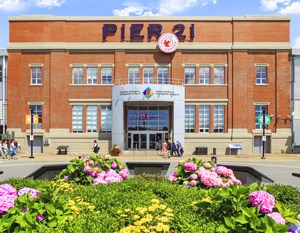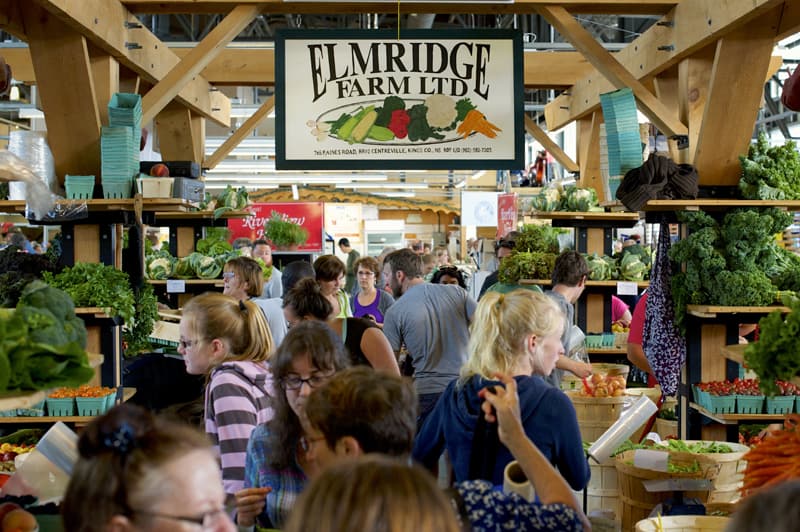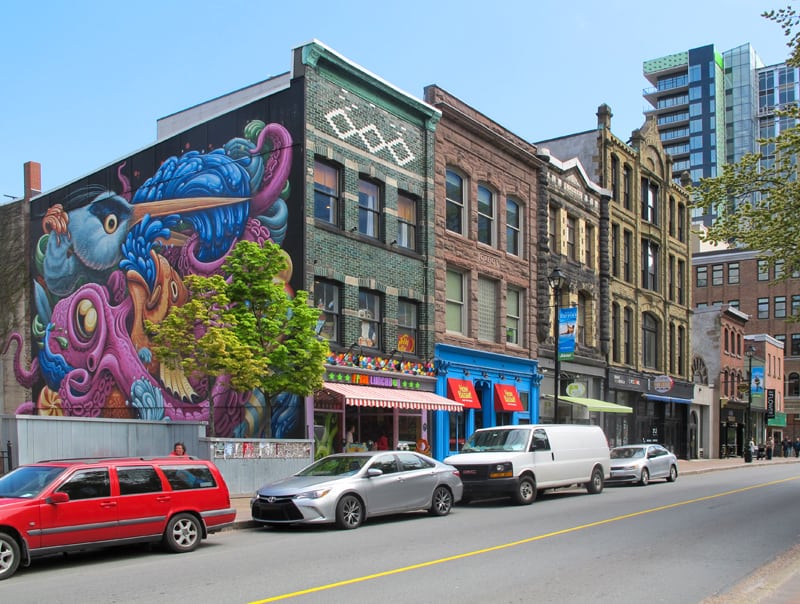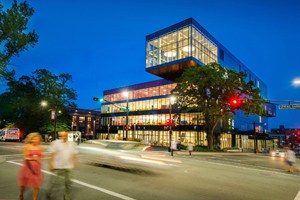Last Updated on December 6, 2023

By Sunny and Al Lockwood
– Adapted from the just-published book “Cruising from Boston to Montreal” by Sunny and Al Lockwood
The natural harbor of Halifax, Nova Scotia – the second largest in the world after Sidney, Australia – is beautiful, and our ship slips in right alongside the pier.
We’ve arrived in the Canadian Maritime’s largest city and one of the country’s most important commercial centers.
The city is North America’s first inbound and last outbound major port of call. And its location, on a rocky peninsula dividing the harbor into inner and outer basins, made it perfect as a military port. In fact, its growth and early economy were directly linked to war or its threat.
A bagpipe’s skirl greets us as we leave the ship. On the harbor boardwalk, the piper in full kilt regalia plays stirring highland tunes. Well, this is Nova Scotia, or New Scotland, so the man and his music provide the perfect start to our day.

Halifax’s Fascinating Immigration Museum
The harbor-side boardwalk has far more attractions than we can visit in a day. But curiosity draws us to the Immigration Museum, housed in a huge brick building at Pier 21. From 1928 to 1971, Pier 21 was Canada’s main east coast reception center for immigrants.
Our tour begins with a film in which recent immigrants from China, India, the U.S., Iran and Pakistan describe why they came to Canada, how difficult the move was and how grateful they are to call Canada home. Several say the kindness of the Canadian people softened the painful edges of their experience.

While my great grandparents came to America from Europe, I have never experienced leaving all behind to start anew in a foreign land.
And so, when I hear how much it hurts to leave (and how dangerous it would have been to stay), the worries that accompany moving to a new world, and how scary it is to start from scratch in an unfamiliar land, I feel my mind and heart expanding. And that often brings a sheen of tears.
After the film, a guide who recently immigrated from Italy, leads us through the immigrant experience. We follow her along the hallway where the newcomers entered Canada. Its high ceilings and wide walls echo with our footsteps.
We enter a room full of wall-sized black and white photographs of early arrivals: bright eyed children, men in worn jeans and caps, their lined faces inscrutable, and weary women in long dresses, holding babies.
“What most immigrants bring with them cannot be packed in a suitcase,” our guide says. “It’s memories, ideas, religion. All these things are carried in the heart.”

Off to the Canadian Interior
Often the next step here was train travel to Canada’s interior. We climb aboard a colonist railroad car. In these Spartan cars the seats served as beds. The small, pull-down berths above the seats were the kiddies’ sleeping quarters. Families brought their own food and bedding. There was little room for luggage.
A kitchen. I can imagine the complications of each family preparing its own food during the journey. It must have been a huge adventure for the kids and extremely stressful for the adults.
Our guide describes the Canadian Mosaic concept. This is the idea that immigrants enrich Canada by adding their culture, language, music, and food to this, their new homeland. Bringing their cultural identity with them increases the overall richness of Canadian culture.
This concept differs from the idea I was raised with, of a melting-pot society where immigrants are expected to replace their previous life and culture with the ways of their new country. Where they’re expected to assimilate.

It strikes me that in being assimilated, persons not only lose their homeland and all that entails, but also in a sense, they lose themselves. What a harsh realization.
I’m not sure what I expected of this museum when we first arrived in Halifax, Nova Scotia, but our visit has been a concentrated exercise in enlightenment.
Continuing along the boardwalk, we come to the Maritime Museum, the oldest and largest maritime museum in Canada. Among its exhibits are 70 small craft and a steamship: CSS Acadian. We would love this museum. But our energy is limited and we want to check out the city’s historic center, so we move on.

Seaport Farmer’s Market in Halifax, Nova Scotia
When we reach the Seaport Farmer’s Market, we’re ready for coffee. Established in 1750 by royal proclamation in Halifax, Nova Scotia, the market boasts that it’s the longest continuously operating market in North America.
The place is huge. There are meat stalls and produce booths and bakeries. Smoothie bars and herb stores. Jars of bright jams and jellies fill shelves while nearby stalls offer cut flowers, jewelry, photographs and paintings. There are sandwich and salad places. Even a creperie.
If you go up to the rooftop, you can enjoy one of the colorful Adirondack chairs arranged there for folks who want to relax and take in the harbor views.
We get coffee from one booth and fresh-baked cookies from another and sit at one of the many tables to enjoy our snack.
Sipping my jo, I think about where we’ll have lunch. When we signed up for this cruise, Al said he couldn’t wait to indulge his love of seafood. Not just ordinary seafood, but “the best” possible. So I searched the web and found a multi-award winning seafood restaurant, The Five Fishermen, at 1740 Argyle Street.

The City Center
After our coffee break, we head uphill toward the city center. When we reach what appears to be a main intersection, we pause to catch our breath. On this one corner in Halifax, Nova Scotia we find buildings that are a mix of Victorian, Georgian, and modern skyscraper architecture. It’s a lively melange for the eyes.
Al pulls a city map from his back pocket, determined to find St. Paul’s Anglican Church. It’s the oldest building in Halifax, and the oldest protestant church in all of Canada.
He turns the map this way and that, trying to find where we are and where the church is, when a voice behind us asks, “May I help you?”
The voice belongs to a well-dressed man who looks to be in his late 20s.
Al says, “We’re trying to find St. Paul’s Anglican church.”
The man types something into his cell phone, and in a moment says, “You’re fairly close. It’s just down this street.”
Then I speak up. “And we want to eat lunch at The Five Fishermen restaurant.”

He types on his phone again and chuckles. “The restaurant is right across the street from the church.”
What luck! This is better than I could have imagined.
“It’s about time for me to get back to work,” he says. “I’ll be going in the direction you need to go, so why don’t we walk together.”
While we walk, he tells us he works in information technology. “I’m sort of a geek,” he says sheepishly. As the guys talk tech, I pause often to take pictures of the captivating architecture. Old and new. Ornate and plain. Historic brick or modern glass. It’s all here in downtown Halifax, Nova Scotia.

The Five Fishermen, a Popular Halifax Restaurant
We find a crew assembling a wooden deck outside The Five Fishermen Restaurant. Saws whine, drills buzz and the smell of sawdust fills the air. When completed, this deck will provide outside dining during summer’s good weather.
Inside, thick stone walls shut out construction noise. The main dining room of the Five Fishermen Restaurant is upstairs and open only for dinner. But this quiet, ground floor grill is just what we need. The decor is modern, warm and inviting. We’re shown to a window-side booth. Mid-day sun pours in, making our wooden table glow.

The menu’s description of Nova Scotia Seafood Chowder sounds good to me. Al announces, “I’m going to order a pound of mussels. Maybe two.”
While we wait for lunch, I share what I’ve learned about this historic building. “You’re going to love the story,” I say. Al smiles and settles in for my tale.
This heritage building was first constructed in 1817 as a schoolhouse. It was the first school in Canada to offer a free education. When the student body outgrew the building and moved elsewhere, Anna Leonowens bought the place.
She opened the Halifax Victorian School of Art. Her school was also successful and eventually she sold the building to new owners, John Snow & Company funeral home. But her true claim to fame is what she did for a living before coming to Halifax.
“The King and I”
Anna Leonowens had worked for the King of Siam. She’d been governess to his children. She wrote a book about her governess experience: The English Governess at the Siamese Court. That memoir brought her fame. Later it formed the basis of a Broadway musical and an Academy Award-winning movie: “The King and I.”

Just as I finish the story of Anna and this building, lunch arrives. My chowder, served in an iron skillet, is a creamy stew of scallops, clams, shrimp and mussels. Unusually delicious, it is neither too thick nor too thin. And, thank goodness, it’s not too salty.
Al’s mussels look as elegantly picturesque in their shiny black shells as if they were gracing the cover of Gourmet Magazine. They snuggle in a broth of fresh herbs, garlic and cream.
One taste and conversation ceases.
We’ve found seafood paradise right here at the corner of Argyle and Carmichael in downtown Halifax, Nova Scotia. Later, we would learn the pivotal role this building and owner John Snow played in recovering bodies from the Titanic disaster.
After lunch, we’re out the door to continue exploring. Directly across Carmichael Street is the Grand Parade, a historic military parade square. City Hall stands at one side of its grassy field. And on the opposite side, St. Paul’s Church. In the middle, a granite and bronze monument commemorates soldiers who served in World War I.

The Citadel Clock Tower, a Halifax Landmark
“I’m heading for the church,” Al says.
Just then I glance back up Argyle Street and see a most dramatic building at the top of the hill. Towering over the city from its emerald hillside stands a white, three-story tall tower atop a one-story white clapboard building. The irregular octagon tower bears a huge clock face.
“Look at that,” I grab Al’s arm and turn him around so that his back is to the Grand Parade and, like me, he’s facing the clock building.

I can’t miss this chance for a closer look at the most intriguing building I’ve seen today. “I’ll meet you at the church,” I say, and head uphill.
It turns out to be a steep hike. A man climbing out of a nearby parked car flashes a thumbs up. I call to him, “What’s the name of that fabulous clock?”
He says it’s Halifax’s answer to England’s Big Ben. Then he laughs.
As I walk back to the sidewalk, he says. “It’s the clock tower for the famous Citadel fortification. We call it the Town Clock or the Citadel Clock Tower.” He heads down the hill, then calls back to me, “It’s been keeping time since October 20, 1803.”
I continue until I reach the foot of the clock tower. Standing here, I realize that this beautiful old clock in its white four-story structure has been keeping time since President Jefferson completed the Louisiana Purchase. The U.S. was just 27 years old, nothing but a lanky youngster about to step across the Mississippi and hike west when this imposing clock began keeping time in Halifax.
It’s a giant grandfather clock. Its gears and weights, bells and pendulums, were commissioned by Prince Edward, father of Queen Victoria.

The Citadel
Ah, yes, the garrison. The Citadel. The big fort at the top of the hill. Our ship offered a Halifax Citadel shore excursion. But the description sounded like too much walking for us. And we’ve seen historic forts in countries from our own to Colombia and Spain, so we’ll save our money and simply explore other Halifax areas.
I photograph the clock tower, then turn back toward the Grand Parade.

On my way down hill, a woman stops me to point out the city’s new convention centre and to tell me how proud Halifax is of it. The center’s curved, radiant glass walls reflect sky and harbor.
In addition to the dazzling architecture here, I’m astonished by the friendliness of locals. It feels like I could belong here. Like this could easily be home.
When I reach St. Paul’s, Al is sitting on the front steps of the big, white, square wooden building. Established in 1750, St. Paul’s interior is tranquil with beautiful windows and many plaques and decorations. Beneath its floor, a graveyard of distinguished historical leaders.

Imagine the prayers that have been whispered within these walls; the weddings, brimming with hope; the baptisms and the tear-drenched funerals. Churches are so central to community life, and to the growth of individual faith and practice. They provide a space to pause and breathe deeply, to experience reverence, to reflect on meaning and the truth that we exist within a reality larger and more mysterious than just our individual life.
This church, built more than two centuries ago continues to hold weekly worship services. It looks strong and sturdy, as if it could easily last another two hundred years.
A Delightful Turn in the City
“I’m ready to go back to the ship,” Al says. We head for the harbor.
I thought I had a good feel for downtown Halifax with its fascinating architecture, but now the city takes a delightful turn.

We’re wandering quieter streets and as I glance down alleyways and around corners, I find we’re surrounded by art. Colorful murals of animals, angels, flowers, and fantastic birds adorn the buildings. No blank brick or cement walls here. The city vibrates with line and color.
We’ve heard that Halifax has the most bars and pubs per capita of any city in North America. Could it also be the city with the most intriguing outdoor murals?
The sun-drenched air turns blustery. We zip up our jackets. The wind, the delicious lunch, the friendly Canadians and this captivating artwork fill me with joy. I could almost skip I’m so happy. I love Halifax, Nova Scotia!
If you’re driving, after a visit to Halifax you may also want to visit beautiful Fredericton, the capital of New Brunswick, about a five-hour drive
You may also enjoy: Trout Point Lodge, Nova Scotia – Luxe in the Wilderness / Prince Edward Island. Small Province. Big Cuisine / Liscombe Lodge: a Canadian Wilderness Retreat / Québec’s Idyllic Île d’Orléans
“Cruising from Boston to Montreal” by Sunny and Al Lockwood, is published by Amazon.

Hi,
You have shared very interesting information about halifax nova scotia, but I like that Halifax’s Fascinating Immigration Museum bcz it is my dream to visit there once in a lifetime. Thank You Keep sharing!
Akshay – I hope your dream comes true!
Please come back when you have more time to explore our city, it was a good read seeing the perspective of a visitor.
Thank you Kevin. I would love to.
Jim